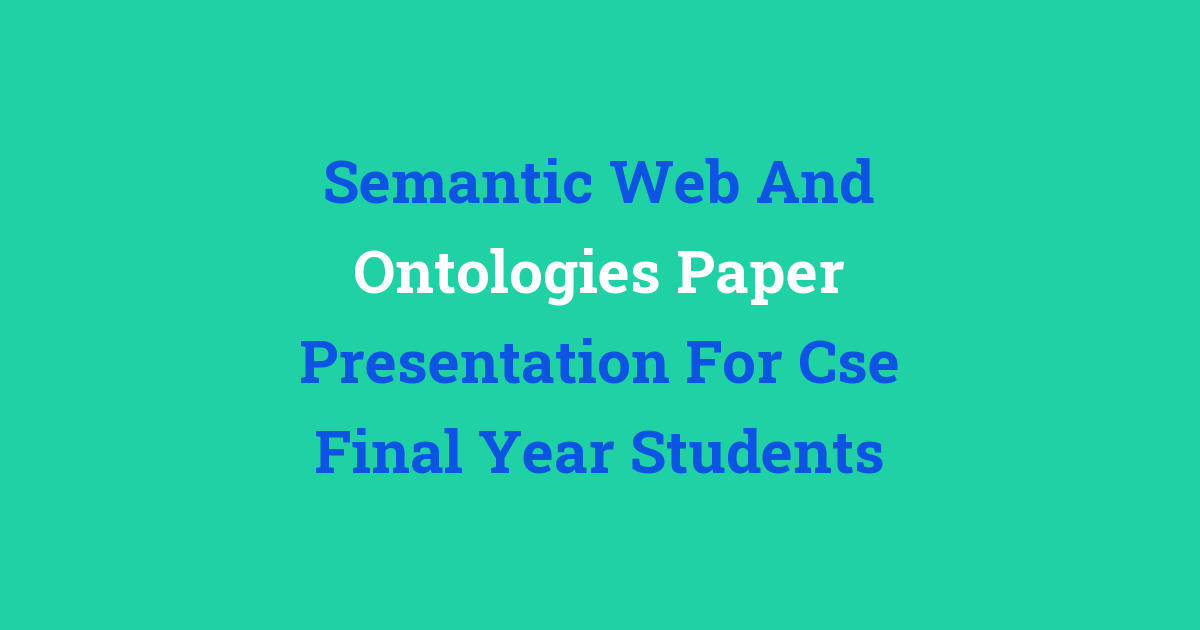“Presentation on Semantic Web and Ontologies for final year Computer Science Engineering students.”
Introduction
In recent years, the concept of the Semantic Web has gained immense popularity in the field of computer science and engineering. The Semantic Web can be defined as an extension of the World Wide Web that enables machines to understand the meaning or semantics of information on the web. Ontologies play a crucial role in the Semantic Web by representing knowledge in a structured and machine-readable format. This paper presentation aims to explore the significance of ontologies in the Semantic Web and propose a new system for improving the existing system.
Problem Statement
The traditional web is based on unstructured data, which makes it difficult for machines to interpret and process information effectively. This limitation hinders the development of advanced applications such as intelligent search engines, recommendation systems, and automated reasoning systems. The challenge lies in representing and organizing data in a meaningful way that is understandable by machines.
Existing System
In the existing system, the web is primarily based on hyperlinks between documents, which lack context and meaning. Search engines rely on keywords to retrieve relevant information, resulting in a lack of precision and accuracy in search results. Furthermore, traditional databases are designed for storing and retrieving structured data, making it difficult to integrate and analyze data from various sources.
Disadvantages
The limitations of the existing system include:
1. Lack of semantics: Traditional web data lacks semantics, making it challenging for machines to interpret and process information accurately.
2. Limited interoperability: Data from different sources is stored in silos, making it difficult to integrate and analyze information effectively.
3. Difficulty in knowledge sharing: Without a common understanding of data, it is challenging to share and reuse knowledge across different applications and domains.
Proposed System
The proposed system aims to address the shortcomings of the existing system by leveraging ontologies to represent knowledge in a structured and machine-readable format. Ontologies provide a formal and explicit specification of a domain’s concepts, relationships, and properties, enabling machines to understand the semantics of data effectively.
Advantages
The advantages of the proposed system include:
1. Semantic enrichment: Ontologies enrich data with semantics, enabling machines to infer relationships and make intelligent decisions.
2. Enhanced search capabilities: By incorporating ontologies, search engines can provide more precise and relevant search results.
3. Interoperability: Ontologies facilitate data integration and interoperability across different systems and domains.
4. Knowledge sharing: Ontologies enable knowledge sharing and reuse, promoting collaboration and innovation in various applications.
Features
The key features of the proposed system include:
1. Ontology modeling: The system allows users to create and customize ontologies to represent domain-specific knowledge effectively.
2. Semantic querying: Users can perform semantic queries to retrieve information based on the meaning and context of data.
3. Knowledge inference: The system is equipped with reasoning capabilities to infer implicit knowledge and relationships from ontological data.
4. Ontology alignment: Users can align and integrate ontologies from different sources to facilitate data interchange and interoperability.
Conclusion
In conclusion, the Semantic Web and ontologies play a crucial role in revolutionizing the way information is represented and processed on the web. By adopting ontologies in the proposed system, we can overcome the limitations of the existing system and unlock the full potential of the Semantic Web. The proposed system offers numerous advantages, including semantic enrichment, enhanced search capabilities, interoperability, and knowledge sharing. With its advanced features such as ontology modeling, semantic querying, knowledge inference, and ontology alignment, the proposed system promises to usher in a new era of intelligent and interconnected web applications.

